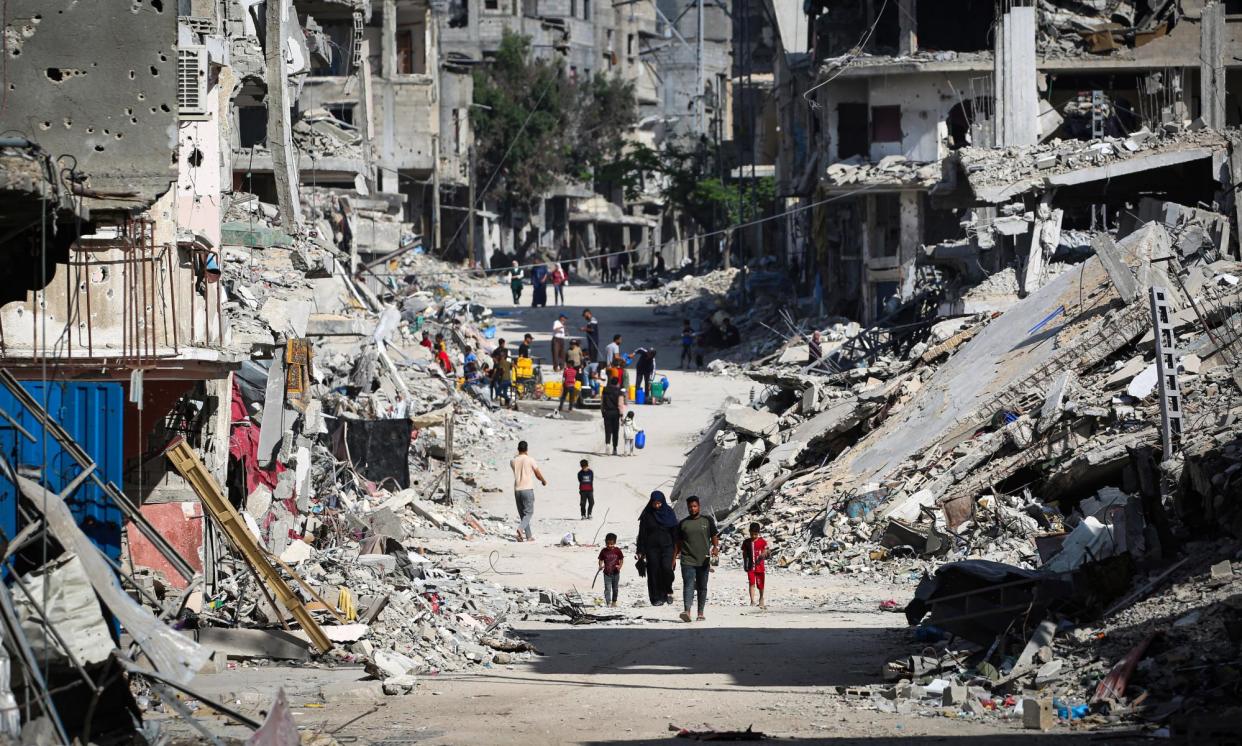Surge in Palestinians applying for protection while in Australia prompts calls to create ‘emergency uplift’ visa

The number of Palestinians applying onshore for protection in Australia has ballooned, prompting calls from refugee advocates for the creation of an “emergency uplift” visa rather than people fleeing conflict relying on tourist visas to escape.
Home affairs department statistics for May revealed 119 people from the “Palestinian Authority” had applied for onshore protection visas, up from 66 in April, 110 in March, 88 in February and 33 in January.
The Palestinian Occupied Territories were the sixth-largest source of onshore protection claims in May, behind China (314), Vietnam (182), Colombia (152), India (148) and the Philippines (129), according to statistics tabled regularly in parliament by the immigration minister, Andrew Giles.
Related: Albanese stands by Fatima Payman’s suspension over Palestine ‘stunt’
Before January, claims from people from the “Palestinian Authority” were so few they were not separately reported, instead assigned to “other category”, implying fewer than about 30 claims a month.
The Refugee Advice and Casework Service (Racs), which is assisting some of the Palestinians, said that “the absolute humanitarian disaster in Gaza” was causing “an increase in arrivals from Gaza and Palestinians seeking protection”.
“Racs has long assisted hundreds of Palestinians … due to their history of persecution, discrimination and statelessness, which has only been exacerbated in recent times,” the nonprofit said.
“When people fear for their lives, they will do whatever it takes to find safety.”
The group said many refugees in Australia did not enter with a refugee visa, but instead “they often arrive using another visa type or through other means” and then they applied for protection once they had arrived.
Racs said Australia had “set a precedent of using tourist visas” for this purpose, including during the Ukraine and Gaza crises, because they have “the requisite security measures” without requiring a full humanitarian application.
Gazan man Hani Abushaban, 23, arrived in Australia on 20 March having had his initial visitor visa cancelled mid-flight, en route from Cairo to Istanbul. His visa was reissued and he is now attempting to make a home in Melbourne.
While his 12-month visitor visa allowed him and his immediate family to flee the war zone, it does not give him the opportunity to work, study or access Medicare in Australia.
His only option, he said, was to apply for a subclass 866 protection visa, which would give him the ability to earn a living independently.
“I’ll apply for it. I have no rights. I have got nothing at all. I am not used to this,” he said. “In Gaza I had a car, I had my own apartment.”
Hani, who worked as a telecoms salesman in Gaza, said he didn’t want to have to “rely on” other people in Australia.
“I have always worked, I had a pretty good life. I want to start building my future and what we have lost in our country,” he said.
“I don’t have any place to go, unfortunately. My home was destroyed in the first three days of the war. The only option is to stay here.”
In April Guardian Australia revealed that Palestinians were being refused visitor visas on the basis they “did not demonstrate a genuine intention to stay temporarily in Australia”.
Now, the expiration of three-month visitor visas appears to be driving an increasing number of Palestinians to claim onshore protection.
Racs said that “what this shows is a gap that needs to be addressed by Australia’s immigration system”.
“The tourist visa is not fit for purpose in these circumstances, and really Australia should be considering an emergency uplift-type visa, similar to that of the 449 visa which was used for those Australia evacuated from Afghanistan, where families, communities and individuals can apply for or request of the Australian government at such times of dire need.”
Related: Australian company denies Greens’ accusations it exports parts for Israeli missiles used in Gaza
The Australia Palestine Advocacy Network president, Nasser Mashni, said the increase in onshore protection visa applications “is hardly surprising, considering that Israel has, by design, made life for Palestinians in their homeland utterly untenable”.
An “adequate” visa option was needed, he said, “for people escaping genocide”.
Mashni cited “wanton bombardment and destruction of homes and civilian infrastructure, its use of starvation as a weapon of war”. Israel has denied its military action in Gaza following the 7 October Hamas attacks constitutes genocide.
The Asylum Seeker Resource Centre said the increase in applications from Palestinians was “likely just due to the fact more people are able to get out”.
“The tourist visa was recommended by the Australian government to help people flee to Australia, and should not restrict that person’s options for what visas they can apply for once they are here.”
Guardian Australia contacted Giles and the home affairs department for comment.

 Yahoo News
Yahoo News 
